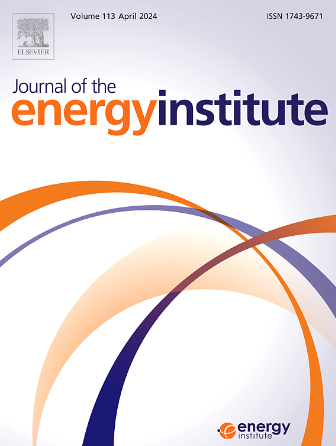Upgrading pyrolysis liquid from high-density polyethylene to fuel-like hydrocarbons by catalytic transfer hydrogenation with a NaBH4 hydrogen donor
IF 6.2
2区 工程技术
Q2 ENERGY & FUELS
引用次数: 0
Abstract
The pyrolysis of plastic waste is a promising upcycling process that recovers high-value chemicals and fuel-like hydrocarbons. However, the high content of unsaturated hydrocarbons in the pyrolysis liquid produces low-stability fuels that are highly polluting and damage engines. Unsaturated hydrocarbons can be converted to saturated hydrocarbons by hydrogenation, which upgrades the pyrolysis liquid and enhances its value. In this work, a pyrolysis liquid obtained from high-density polyethylene was upgraded by the catalytic transfer hydrogenation of alkenes in a one-pot reaction over metal catalysts using sodium borohydride (NaBH4) as a liquid hydrogen source in place of hydrogen gas. Both single metal catalysts (Co, Cu, Fe, Ni, and Mn) and binary metal catalysts were used. The binary catalysts were all based on Cu (Co/Cu, Fe/Cu, Ni/Cu, and Mn/Cu). Co and Ni showed significant catalytic activity for upgrading the pyrolysis liquid with alkene conversion of 61 % and 52 %, respectively. Co/Cu introduced synergetic catalytic activity and increased the alkene conversion to 66 %. While Fe and Mn/Cu catalysts did not support the hydrogenation of alkenes. The ratio between Co and Cu at 4:1 in the binary metal catalyst led to the highest alkene conversion, and the NaBH4 loading also influenced the conversion of alkenes. The feasibility of hydrogenating alkenes at room temperature was investigated. This simple, green, and economic hydrogenation process converted up to 77 % of unsaturated hydrocarbons as alkenes to saturated hydrocarbons as alkanes. The alkane content in the processed pyrolysis liquid was as high as 80 %.

用NaBH4氢供体催化转移加氢将高密度聚乙烯热解液转化为类燃料烃
塑料垃圾的热解是一个很有前途的升级回收过程,可以回收高价值的化学品和类燃料碳氢化合物。然而,热解液中不饱和烃的高含量会产生低稳定性的燃料,对发动机造成高污染和损坏。不饱和烃通过加氢转化为饱和烃,使热解液升级换代,提高了热解液的使用价值。采用硼氢化钠(NaBH4)作为液氢源代替氢气,在金属催化剂上进行烯烃催化转移加氢的一锅反应,对高密度聚乙烯热解液进行了升级改造。采用单金属催化剂(Co, Cu, Fe, Ni和Mn)和二元金属催化剂。二元催化剂均为Cu基催化剂(Co/Cu、Fe/Cu、Ni/Cu和Mn/Cu)。Co和Ni对热解液的催化活性显著,烯烃转化率分别为61%和52%。Co/Cu引入协同催化活性,烯烃转化率提高到66%。而Fe和Mn/Cu催化剂不支持烯烃的加氢反应。在二元金属催化剂中,Co与Cu的比例为4:1时,烯烃转化率最高,NaBH4的负载对烯烃转化率也有影响。研究了常温下烯烃加氢的可行性。这个简单、绿色、经济的加氢过程将77%的不饱和烃转化为烯烃,饱和烃转化为烷烃。加工后的热解液中烷烃含量高达80%。
本文章由计算机程序翻译,如有差异,请以英文原文为准。
求助全文
约1分钟内获得全文
求助全文
来源期刊

Journal of The Energy Institute
工程技术-能源与燃料
CiteScore
10.60
自引率
5.30%
发文量
166
审稿时长
16 days
期刊介绍:
The Journal of the Energy Institute provides peer reviewed coverage of original high quality research on energy, engineering and technology.The coverage is broad and the main areas of interest include:
Combustion engineering and associated technologies; process heating; power generation; engines and propulsion; emissions and environmental pollution control; clean coal technologies; carbon abatement technologies
Emissions and environmental pollution control; safety and hazards;
Clean coal technologies; carbon abatement technologies, including carbon capture and storage, CCS;
Petroleum engineering and fuel quality, including storage and transport
Alternative energy sources; biomass utilisation and biomass conversion technologies; energy from waste, incineration and recycling
Energy conversion, energy recovery and energy efficiency; space heating, fuel cells, heat pumps and cooling systems
Energy storage
The journal''s coverage reflects changes in energy technology that result from the transition to more efficient energy production and end use together with reduced carbon emission.
 求助内容:
求助内容: 应助结果提醒方式:
应助结果提醒方式:


